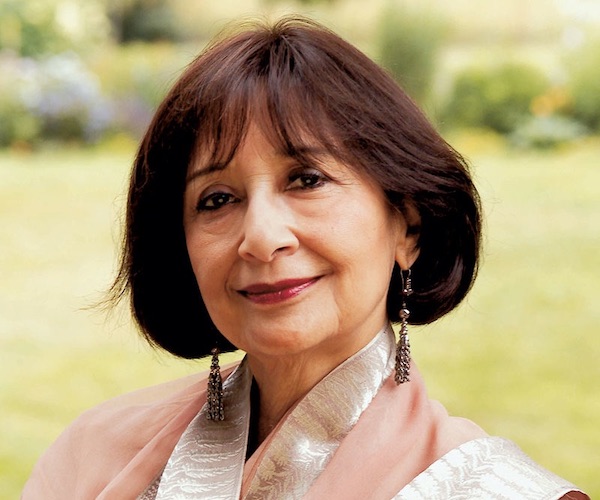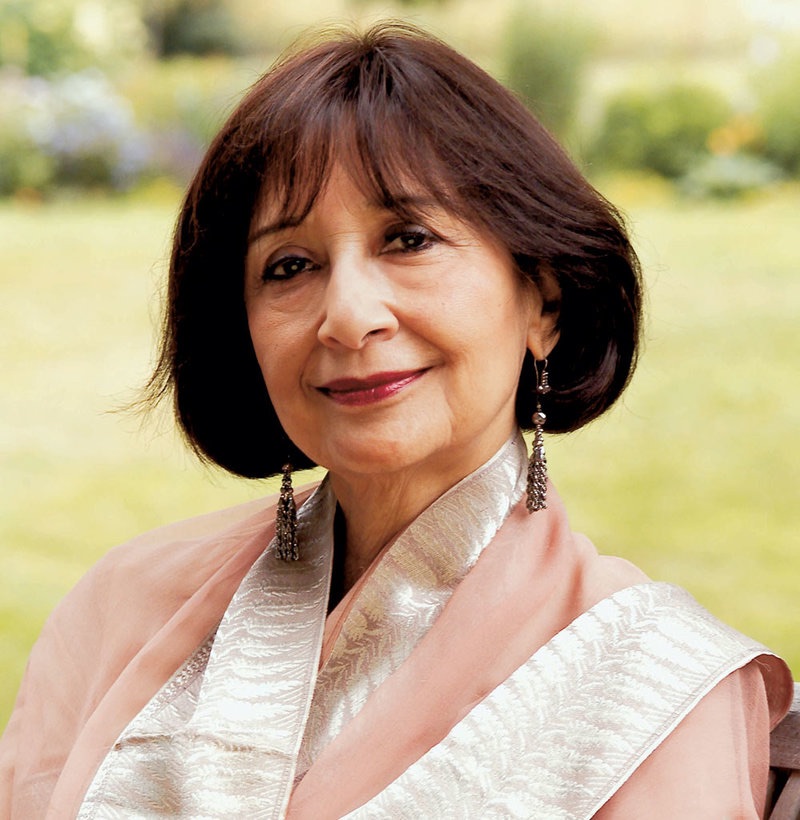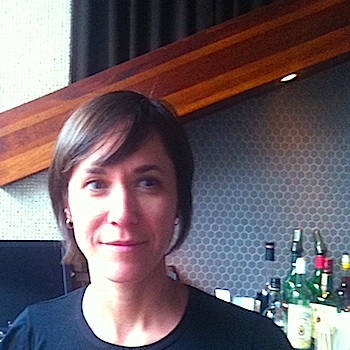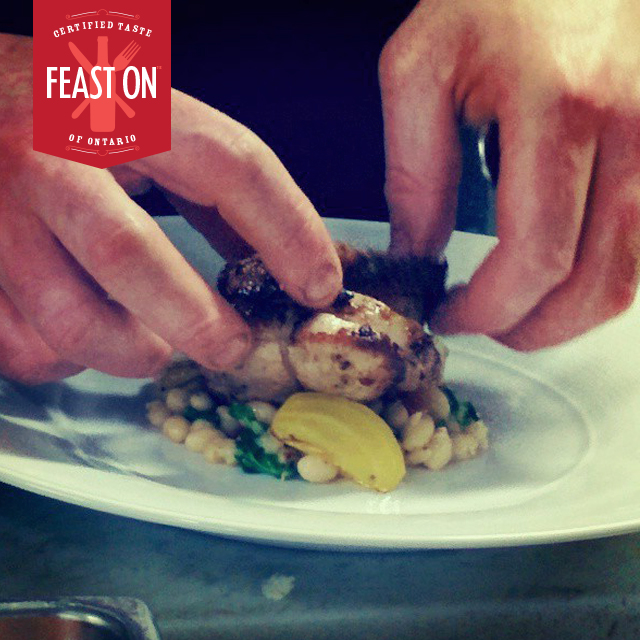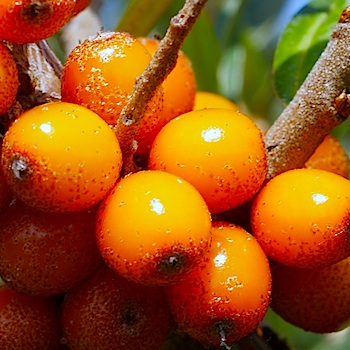Malcolm Jolley mines the Gremolata archives and finds Madhur Jaffrey…
In the first decade of the century, before smart phones and social media there were just plain old websites. Gremolata.com, the first website in Canada to publish as a food and wine magazine was begun in 2004 by yours truly and had a decent run until 2009, when it all fell apart. I am not one to dwell on the past, and have spent the past decade looking forward at Good Food Revolution with Jamie Drummond. But when a former writer for Gremolata asked me to pull an article he had written from my archives I had a look around for the first time in a long while and thought some of it might be worth sharing again, and so have created for GFR these Gremolata Files.
Landing the interview below, with Madhur Jaffrey, was very exciting and I felt like I had made it to the big leagues of food journalism. It was held in an empty office at what was then the Random House Canada HQ at King and Toronto Streets. Jaffrey was on a promotional tour for her memoir, Climbing the Mango Trees. It’s one of my most memorable interviews; Jaffrey was warm, funny and good company. It was also a pleasure to edit, when I transcribed it from my recording, because as a trained actress she spoke in perfectly formed sentences, without an “um” or “err” to be heard.

Gremolata: Is Climbing the Mango Trees a food memoir?
Madhur Jaffrey: I have no idea what it is officially. It is a memoir with a lot of food in it. I wasn’t trying to write about food, actually. I was just trying to write about my life as a child and there’s so much food in it that it sort of comes in automatically.
G: The food sounds fantastic. In some ways, I thought, the food you describe eating in the 1930s is thoroughly modern. It’s all organic, you know exactly where it comes from…
MJ: Well, you see that’s the thing: nobody knew all those words then. But everything was fresh, from a nearby farm or our own garden. The milk would come that day from our own cows. It was assumed that that was the right thing to do things. If you begin reading, you’ll see that the old Ayurvedic system of medicine has been saying forever that you should eat things that are grown close to you, that are grown properly. You know, all that which we know call organic and these wonderful newfangled names for it: that was the way to do things. There was no other way to things in India.
G: Does all that remain?
MJ: Some of it remains, but the country as a whole is slowly being Monsantofied, or whatever seeds are coming from the West. It’s all changing and there’s havoc as a result. So, we are also having to say, “Stop, stop, stop. Let’s go back.”
G: Your memoir has an Arcadian feel with the gardens, going to pick out chickens, and all that. But the world you describe is also very cosmopolitan and layered. From the centuries of history, the various rulers in Delhi and their influences and then the influx of refugees at the time of partition. The English, too – you’re always eating soup.
MJ: Yes, I thought that English food was always soup; that they had to get some liquid in them before they could get the rest of their meal down!
But it’s interesting. Sometimes when you are very specific – and write, really, about Delhi and my growing up in a very specific kind of circumstance – it becomes universal. In many ways what happens in one place happens in another place and sometimes in the whole world. The whole conflict that was to flare up between Muslims and Hindus, that was going to partition the country had its origins way, way back when Islam first came to India. And certainly, my family has historically lived through all the elements that made up for the final partition of India: the Muslim element because my family worked for the Moghul Emperors and the British, who my family also worked for after the Moghul Empire crumbled (thanks to the British). When they took over my family just shifted and many were working for them. Taking notes
G: This is your caste?
MJ: This is our caste: scribes, historians, writers and accountants for 2,000 years. My whole theory is that we wanted to read and write but we didn’t want to be like the priests who read and wrote religion. We wanted to have a bigger field, a more intellectual field and we became scribes and maintained it. Until now – and it’s ironic that I’m writing, my daughter’s writing and there are many writers in the family who just somehow do it. They don’t even think about it. Ink is in our blood.
G: I’m skipping ahead of the scope of the book, but you left India for England to become an actress, so how did you become one of the foremost authorities on Indian food? A famous cookbook writer?
MJ: I have no idea. It’s a total mystery to me. My grandkids dream of being chefs, but I had no such dreams. No such dreams. And I don’t call myself a chef, all I call myself is a cook.
When I left India and couldn’t cook at all at 20 I started writing to my mother and she sent me back air letters, so I started with these air letters and began cooking. And then, I came to America and, as promotion for a film that I’d done, Craig Claiborne of the New York Times did an article on me as ‘an actress who liked to cook’. It was really about the film Shakespeare Wallah, but from there these strange doors began to open. I didn’t solicit any of it – I always say I’ve been dragged kicking and screaming into the world of food. It just happened to me: I kept making a very bad living as an actress and a very good living as a writer about food.
G: A friend gave me your Ultimate Curry Bible, and I absolutely love reading it in bed. I mean I love all the stories about the food. It’s clearly very thoroughly researched.
MJ: Yes. I still do that. Research is the greatest; I prefer that to writing, actually. I love going around finding and discovering. That’s the highlight of the book writing process for me.
G: So, how much of the memoir could you call up then?
MJ: It was a very funny process because when I was asked to do it by my editor, more than 10 years ago, I said, “I can’t. I can’t remember what I did yesterday. How will I ever write a memoir? I never even kept diaries – nothing!” Even today, I can’t think about what happened in the past.
But then, I began thinking. I began thinking about he food that we ate as kids, the emotional things attached to the food, and the food attached to the emotions. Suddenly it came back in a rush. I just all poured out.
There were things I couldn’t remember, so I would call or email to various brothers and sisters: what was the colour of that car in 1946? And each would email me back a different colour. So, I thought, it doesn’t matter! Memory is totally selective. You remember what you want to remember, or what you think you remember. It’s no use, almost, asking anyone anything. So, from then on I felt free to go with what I remembered. Though some things I still had to consult my brothers and sisters about.
G: And is everyone happy with the result?
MJ: No! Of course not. That’s why I don’t want to touch memoirs again. It’s a Pandora’s box.
G: But you have to write the next book. The next chapter of your life.
MJ: Well that’s it. I dare not because already there’s enough people angry with me. And you know, the people who are the angriest, I praise the most. I think that people are just not used to being in print. And you somehow break into their lives when you write about them you expose them in a way they don’t want to be exposed. Even when you think something is the least of things, you’re exposing them and I think it’s dreadful for them.
I’m used to it, being in the public. And I carefully shield what I don’t want people to know.
G: In the book you describe a fascinating life in terms of being in a very interest place in a very interesting time: the last days of the Raj, the Second World War, Independence, Partition…
MJ: Right. I never knew it was so. In retrospect, I suppose it is so, but when you’re living it, you’re just living your life. I didn’t think, ‘I’m living in historic times’. I was just so angry about the partition and so fearful of what would happen. And then Gandhi’s death. We were all great supporters of Gandhi, great followers of Gandhi: my father, my mother, my brothers, all of us. And then he was killed and we thought there’s going to be chaos. What we stand for is this kind of great tolerance and accepting everyone whomever they are. India must be a secular nation, it cannot be a country of these people or that lot of people. And suddenly it felt very threatened, all that. But somehow over the years it’s managed to stay, more or less, on an even keel, which is amazing.
G: You’re based in New York. You’re on your third continent.
MJ: Right.
G: And you go back to India often?
MJ: I do. I do all the time. Most of my family is there. As you know, I come from a huge family, so there are a lot of us there.
G: One of the interesting food things in your book is when you talk about partition and Punjabi refugees who brought all these wonderful new foods like naan to Delhi.
MJ: Which I had never heard of.
G: In the west we assume that every one in India eats the dame things.
MJ: Yeah. We had never heard of naan and to us it was as exotic as it was perhaps to someone eating it for the first time in Canada or Britain or in America or whatever. So, it’s hard to explain to people that India is the size of Europe. It’s such a huge country and it’s like Europe, the differences like being in Sweden, then Italy or Spain, the Ukraine. The food is just totally different. And that’s the exciting part of India, for an Indian too, travelling and eating. It’s just great.
G: And this is still happening to you, isn’t it? You still discover new foods.
MJ: You never stop learning about anything. Certainly not abut food in India; it’s a never ending process.
G: Is there something that food-fashion-forward Westerners ought to be on the eye out for? A new dish from India that hasn’t been discovered?
MJ: Oh, I would say there are a million that have not been discovered. I was in an airport in Sri Lanka, in Colombo, and I was talking to an Indian who was returning to India as I was coming back to New York. She was from Andhra, one of the states in Southern India, and she was telling me about the three distinct types of regional foods from there and the various dishes. I didn’t know any of them.
There’s someone else I know who is now the Governor of Arunachal Pradesh, which is in the north and the east of India. It borders China. I’ve never been there and would like to go because the food is totally different.
Even in places where I’ve lived, people make dishes that I do not know! It’s endless. It’s been going on for thousands of ears. It’s not like American cuisine, or Canadian cuisine, which is basically new. It comes for old sources, but it’s basically new. In Indian cuisine is so old and each family has its own dishes that have stayed with them only for thousands of years.
G: So each family has their own dishes and their neighbours…
MJ: Would be eating totally different things. Take mango pickle. It’s not universal, mango pickle. It’s going to be different in each family.
G: This is like de Gaulle saying, “How can you govern a country with 300 cheeses”. Actually, it’s exponentially worse!
MJ: Exactly!
G: Although, when I read the book I recognise some dishes and spices, as someone who doesn’t know very much.
MJ: The spices are the same. It’s like a palette of colours. Every painter has the palette of colours, but it’s how they’re used. What is emphasised? What is the base oil? What spices are they putting on the fore? What other ones are they putting in the background? How are they breaking things up? And that makes all the difference.
G: Are there violent disagreements about this sort of thing?
MJ: Within regions there’s a history of spices being used in a certain way. But even in our region, there’s garam massalla, which is a mixture of aromatic spices which Ayurvedically heat the body. It’s used throughout North India, but everyone, every family has there own mixture.
G: So when I go to the super market and buy a jar…
MJ: Forget about it.
G: That bad?
MJ: You can use it but what happens in a jar is that they try to get the maximum profit for the minimum input of spices so they fill it with the cheapest spices. In my spice mixture, when I make garam masala the most I have is cardamom seeds. That’s one of the most expensive spices. And there’s cloves, cinnamon and nutmeg, which are expensive. They fill theirs up with more coriander and cumin, the cheaper ones.
I know this because I use them and I know which the good mixtures are, and even those you cannot use like my homemade mixture. So, sometimes in my recipes I’ll say, two teaspoons of the one you get from the market – it’s fine here. But for others, Ill say, you have to use my mixture and you need only a half teaspoon.
G: So for the recipes at the end of the memoir…
MJ: These are the family recipes.
G: Right. Could a novice start with your garam masala and then expand on it?
MJ: Sure. Absolutely. That’s what Indians do.
G: Spices like coriander and cardamom seem to be popping up on every fusion menu.
MJ: I just went to Susur Lee’s second restaurant.
G: Lee’s.
MJ: Right, and he had used cardamom seeds in a few things.
G: Appropriately?
MJ: Hmm. Well, I don’t know. It’s a question of taste. I mean your palette, how you are putting these things together. Sometimes it works beautifully, and sometimes – to my mind, and all minds are different – it doesn’t work so beautifully. I find, for example, the Swedes use cardamom in their desserts. It’s one of the main ingredients, like vanilla. They must have got it very early on from, I don’t know, Sri Lanka. Could be from there. So they use it in their spice cakes and it’s wonderful, to me a perfect idea. But people are now traveling so fast and incorporating a whole lot of things: coconut, cardamom, this, that… You have to be careful.
G: That’s very diplomatic. I thought it was interesting that you compare Indian food sensibilities to Italian. I’m thinking of the emphasis on fresh produce.
MJ: It’s that. Also it’s a grain based diet like Italy. I think we have a lot in common: very fresh vegetables, at least in homes. In Indian homes you get everyday one, or two, or three very fresh vegetables, which are cooked very nicely and simply. That, I think, you find in Italy.
It’s a similarity of mind: you eat a lot, you sleep a lot, you listen to good music. It’s that way of thinking that Indians have as well.
G: They’ve figured out how to live.
MJ: Yeah. It’s a wonderful way to live, actually, with good food as part of a way of life, as opposed to adding it on at the end of the day.
G: For a home cook who’s not familiar with the traditions of Indian cuisine, where’s a good place to start?
MJ: Start with the recipes at the end of the book. But I always try and tell people, “Just don’t try and make a whole meal.” You’ll kill yourself and say that you’ll never do it again. Take for example the meatballs in this book. They’re fairly complicated, so just make the meatballs and buy naan from a shop and make a salad. And that’s all: don’t try anything else. Make it a few times, then add an Indian vegetable dish, then add a rice or a chutney, or a raita. But don’t get overwhelmed. Make one dish many times until you have grasped it.
Also, don’t buy too many spices. Just buy the ones you need for that dish.
G: Buy small amounts of spices because they go bad?
MJ: Well, if you buy them whole, then they won’t go bad. Only the ground ones. So get a coffee grinder for grinding and grind in small quantities.
That’s how I learned: literally one recipe at a time. I kept doing them until I got it right. And then another one and another one. So, I’m just passing on my method, actually.
G: And, at the time, you would have been at the mercy of English purveyors.
MJ: Yes, but everything was coming in. If you look at the 19th Century they were bringing things in. There was quite available when I was a drama student and that was the late 50s.
G: So, no excuse, seek it out?
MJ: Seek it out. No excuse! Have will, will travel.
G: What’s your next project?
MJ: Film and television continue: I’m just doing a Law & Order this week. So that goes on. Cookbooks generally go on. I have some cookbook offers that I will do, probably. But I think I might want to write a novel. I just haven’t decided. But I think that’s where I am at the moment.
G: My impression from reading the memoir is that you enjoyed writing it.
MJ: I did. I did.
G: And will we see more of you in Gourmet?
MJ: Absolutely. I’m going to Sri Lanka and The Maldives to do a big piece. And I write for the Financial Times, I do columns for them.
G: How many books have you published?
MJ: I have no clue. I would guess it’s under 20. You’ll have to go with that!
From David Leite’s leitesculinairia.com: Madhur Jaffrey’s Moghlai Lamb with Spinach.

